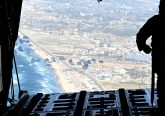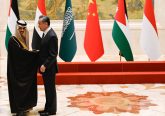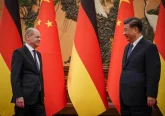 The recent visit to Beijing by the U.S. secretary of defense, Leon Panetta — which coincided with State Department statements that the U.S.-Japan security treaty would apply to the disputed Senkaku Islands — highlights the growing tension with China over America’s military presence in Asia, Chinese efforts to counteract it, and the dangerous misperceptions that can arise if defense strategy gets in the way of diplomacy.
The recent visit to Beijing by the U.S. secretary of defense, Leon Panetta — which coincided with State Department statements that the U.S.-Japan security treaty would apply to the disputed Senkaku Islands — highlights the growing tension with China over America’s military presence in Asia, Chinese efforts to counteract it, and the dangerous misperceptions that can arise if defense strategy gets in the way of diplomacy.
The U.S. military strategy underpinning the Obama administration’s “pivot” to Asia is known in Pentagon circles as “Air-Sea Battle.” It depends upon the long-range capabilities of the U.S. Navy and Air Force to overcome the mines, submarines, anti-ship missiles and other advanced technology designed to keep the U.S. military out of “exclusion zones” established by potentially hostile powers.
Although applicable to Iran, Air-Sea-Battle has attracted the most attention in the Asia-Pacific region, where America’s allies see it as a way to respond to an increasingly confrontational China. Beijing, in turn, has interpreted it as a clear sign of Washington’s aggressive policy toward the People’s Republic.
While the Senkaku island crisis raged last week, I was in Beijing, meeting with a variety of members of China’s strategic community. These consultations strongly suggest that Beijing views both Air Sea Battle and the broader “pivot” to Asia as provocation. At the same time my discussions suggested that there was very little awareness among the people I met about how the People’s Liberation Army’s own strategies or Beijing’s forceful regional diplomacy — which in recent years has sometimes bordered on belligerence — might alarm its neighbors.
On the contrary, many officials expressed the belief that only by forcefully pressing China’s position abroad would the country win the respect and cooperation of other great powers.
For their part, American officials take pains to emphasize that Air-Sea -Battle is not directed at any one country, but is designed to maintain the military capabilities necessary to uphold security guarantees in the Middle East and Asia-Pacific. In private, though, these officials admit the obvious, that the planning for Air-Sea-Battle is designed for a possible conflict involving Taiwan or a dispute over the South China Sea.
Each side views its own military preparations as defensive and the other’s as hostile. Under the circumstances, it is no surprise that their public proclamations of a desire to work for harmonious relations ring hollow, at least to each other.
The Stockholm International Peace Research Institute estimates that China spent $129 billion on its armed forces in 2011, a significant portion of which is dedicated to acquiring “anti-access” capabilities. Despite headline-grabbing spending, China’s military technology and armed forces are largely untested. Its last large-scale military clash was a failed invasion of Vietnam in 1979.
More importantly, Beijing’s primary security concerns are internal, which means that a significant portion of the Army’s personnel and resources is devoted to guarding the country’s borders and supporting public-security forces. Moreover, efforts to ensure that the Chinese Army is sufficiently divided to prevent it from becoming an independent power base that could threaten Communist Party control have had a deleterious impact on military effectiveness.
Americans tend to view the U.S. military as the guarantor of an international order that benefits nations across the globe, whether by maintaining stability in the Gulf and thereby safeguarding oil flows to Europe and Asia, or by providing a security overlay that has allowed nations in Europe and Asia to set aside rivalries and concentrate on mutually beneficial economic relations.
Yet it is not hard to see how the United States would appear threatening to China, particularly when it spends six times as much on defense and has formal alliances or strategic partnerships with the third, fourth and fifth strongest military powers in Asia.
Policymakers in Beijing must recognize that U.S. military forces have global commitments and that only a portion of these are dedicated to the Asia-Pacific. Despite the rhetoric of President Obama’s “pivot,” U.S. Army and Marine Corps forces in the region will merely be restored to pre-Iraq-war levels — no new permanent deployments are being contemplated — while the overall U.S. defense budget is set to decline by $487 billion over the next 10 years.
I do not suggest that the United States back away from Air-Sea-Battle or from its broader efforts to confront the anti-access threat. America’s ability to project military power abroad is necessary for protecting democratic rule, retaining access to important trading partners and reassuring allies of American commitments to them.
However, this concept must be imbedded in a broader political strategy that recognizes the deep-seated insecurity of China’s strategic community. A key aspect of that strategy must be a broad-based engagement with China’s top leadership, academics and strategists, as well as its next generation of military leaders.
Frequent and frank dialogue about the reasons for U.S. military modernization, and about China’s own military capabilities and behavior, need to be part of that conversation, as do the benefits of sustained collaboration between the world’s two largest economies.
In contrast, a narrow focus on military strategies fosters the kind of mutual suspicion that can escalate into costly rivalry. Both countries need to remember that military plans are worst case scenarios designed to hedge against risk, not statements of preferred outcomes.
Walter C. Ladwig III is an assistant professor of international relations at the University of Oxford and a visiting fellow at the Royal United Services Institute.
This article originally appeared in the International Herald Tribune and is reposted here with the permission of the author and the publisher. © 2012 International Herald Tribune








No Comment